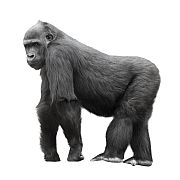- Navigating Your Midlife Crisis: Embracing New Possibilities
- City Raccoons Showing Signs of Domestication
- Mapping the Exposome: Science Broadens Focus to Environmental Disease Triggers
- One Week Less on Social Media Linked to Better Mental Health
- Your Brain Changes in Stages as You Age, Study Finds
- Some Suicide Victims Show No Typical Warning Signs, Study Finds
- ByHeart Formula Faces Lawsuits After Babies Sickened With Botulism
- Switch to Vegan Diet Could Cut Your Greenhouse Gas Emissions in Half
- Regular Bedtime Does Wonders for Blood Pressure
- Dining Alone Could Mean Worse Nutrition for Seniors
Half of Known Strains of HIV Originated in Gorillas


(HealthDay News) — Since HIV first appeared in humans in the early 1980s, scientists have been laboring to discover where and how the AIDS-causing virus first developed.
Now, an international team of researchers says it has confirmed that two of the four known groups of HIV strains affecting humans originated in western lowland gorillas in Africa.
HIV-1 has four known groups, M, N, O and P, explained a team led by Martine Peeters, of the University of Montpellier in France.
According to the researchers, prior studies have shown that groups M and N originated in chimpanzees in southern Cameroon.
This new study shows that groups O and P originated in western lowland gorillas in Cameroon, the team reported March 2 in the Proceedings of the National Academy of Sciences.
Although all four subtypes of HIV can infect humans, only one — Group M, found in Cameroon chimps — eventually migrated to spur the AIDS epidemic that has killed millions of people worldwide, the researchers said.
Group O viruses have also infected a relatively large number of people, about 100,000 in west central Africa. However, HIV from groups N and P have so far only been identified in just a few people each, in Cameroon.
“Understanding emerging disease origins is critical to gauge future human infection risks,” Peeters said in a news release from the University of Pennsylvania, which also took part in the new study.
“From this study and others that our team has conducted in the past, it has become clear that both chimpanzees and gorillas harbor viruses that are capable of crossing the species barrier to humans and have the potential to cause major disease outbreaks,” Peeters explained.
The study was funded in part by the U.S. National Institutes of Health.
More information
The U.S. National Institute of Allergy and Infectious Diseases has more about HIV/AIDS.
Source: HealthDay
Copyright © 2025 HealthDay. All rights reserved.










